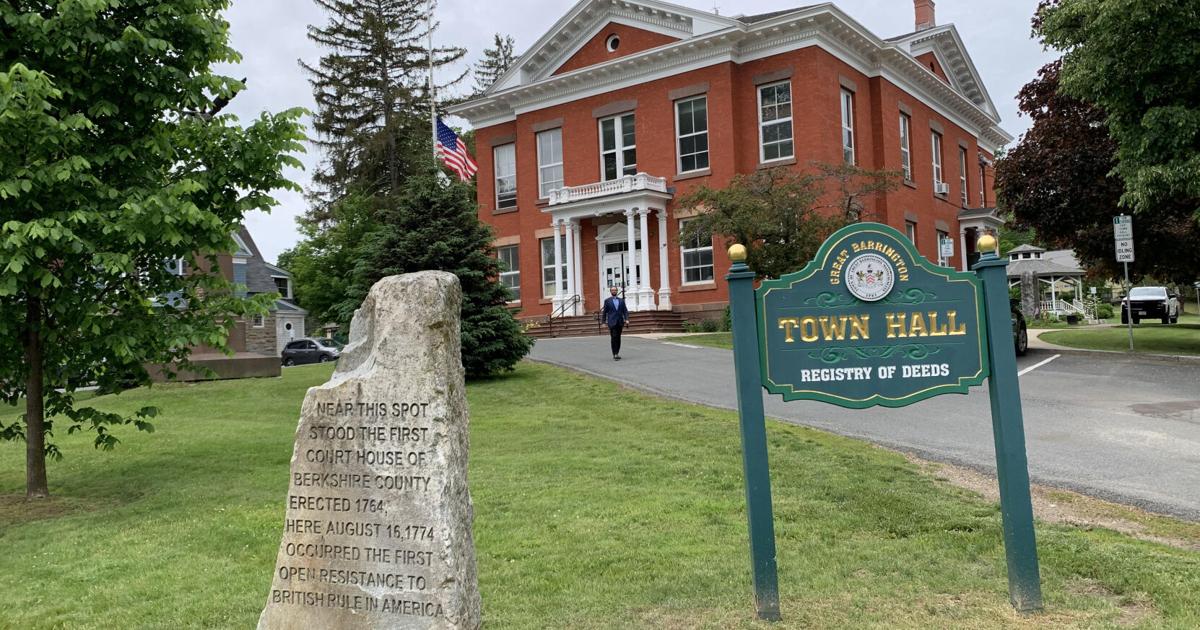By By Justin F. Jackson
Copyright berkshireeagle

Revolutions are not tea parties. And yet how we remember the American Revolution makes it seem far less chaotic, divisive and violent than it really was.
Look no further than the lawn of Great Barrington’s town hall, a few feet from the corner of Castle and Main streets. Since 1890, a small stone monument there has commemorated this, the location of Berkshire County’s first courthouse, as site of “the first open resistance to British rule in America.”
Indeed, this simple monument, facing east, seems proudly to defy Boston almost as much as Britain — as if to imply that the Berkshire men who closed the court here in August 1774 showed more courage than brethren who had recently turned Boston harbor into “a teapot.”
Like Boston’s Tea Party, however, Great Barrington’s monument evokes deep ambiguity in the Revolution’s memory. Literally and figuratively, the marker sits in the shadow of government buildings that project law, order and authority. Yet the “resistance” it honors involved an act that any law-abiding person, then or now, would recognize as a heinous crime: kidnapping.
Great Barrington’s memorial thus renders the Revolution safe for public consumption. What many at the time perceived as treason, insurrection or a “civil war” becomes instead a story of rebellious colonists who simply revered the law and wished to restore it.
PROTEST BECOMES REBELLION
Yet the Tea Party of March 1773 was the largest single criminal act of property destruction in American history. To protest a law granting the East India Company a monopoly on the sale of tea in North America, Bostonians sworn to secrecy dumped into the sea 42 chests of the stuff (today worth almost $2 million). To avoid accountability, the protestors disguised themselves. Even after independence, only a handful ever admitted they “partied” with the detested substance.
Revolutions prompt this alchemy of memory-making. Americans transformed the reality of coercion by which they fomented a revolution into a national origin myth in which British oppression brought principled, peaceful and law-abiding colonists to the brink of war. That useful story emerged from the Revolution itself. Patriot leaders like John Adams, a lawyer who defended the British soldiers that killed five Bostonians in 1770, tried desperately to keep disciplined protests from devolving into disorderly mobs.
CROWDS, CHAOS, COERCION
Yet the Revolution grew out of unruly “crowd actions” that tested law’s boundaries, if not also propriety.
The Sons of Liberty who pioneered Boston’s opposition to British policy emerged in part from anti-Catholic street gangs. Each November, they celebrated the anniversary of the failed “Gunpowder plot” to blow up Parliament by drunkenly battling for an effigy of the Pope and demanding wealthy Bostonians pay for their revelries.
In 1764, one of rioters’ carts accidentally crushed and killed a young boy. The next year, some of the same men harassed, beat, and tarred and feathered customs officials enforcing the Stamp Act. They looted and destroyed Lt. Gov. Thomas Hutchinson’s North End mansion.
INTOLERABLE ACTS IGNITE BERKSHIRE
In the Tea Party’s aftermath, the danger that mob violence might impugn colonists’ high-minded appeals to the law was omnipresent. In early 1774, Parliament responded to the breakdown of order in Boston by sending troops to re-occupy the town and enacting a series of punitive measures, which enraged colonists deemed the Intolerable Acts.
Closing Boston’s port, London suspended rights to a jury trial. It also revoked the Massachusetts charter’s guarantee of local self-government. Suspending most town meetings, Parliament empowered the royal governor to appoint local officials. That prerogative extended to members of the Governors’ Council, the legislature’s upper house, which the directly elected members of the lower house previously chose themselves. Gen. Thomas Gage was named the new governor.
Irate colonists harassed and intimidated Gage’s appointees and their allies. In this incendiary environment, Great Barrington saw the first of many attempts in late 1774 to disrupt Massachusetts courts.
Incorporated in 1761, the town of Great Barrington contained a Whig faction that had chastised their representative in the General Assembly, Sheffield’s Col. John Ashley, after he voted to rescind a letter protesting British taxes.
In July 1774, at Stockbridge, however, Ashley chaired a countywide meeting of 60 delegates protesting the Intolerable Acts. (The clerk was Theodore Sedgwick, author of the Sheffield Resolves.) Endorsing Bostonians’ call for a new continental boycott of British goods, conventioneers pledged “strict obedience to all constitutional laws,” discouraged “all licentiousness” and demanded the “suppression of all mobs and riots.”
SHUTTING DOWN THE COURTS
Early the next month, men throughout Berkshire County converged on Great Barrington to shut down the Inferior Court of Common Pleas.
On Aug. 15, 1774, Pittsfield voters signaled their probable sentiments. It was “highly necessary,” they declared, that “the People of this Province fall into a State of nature” until these “injurious oppressive & unconstitutional acts” were repealed.
The next day, according to local historians, a mass of men armed with muskets, scythes and pitchforks — 1,000 from the Berkshires and several hundred from Connecticut’s neighboring Litchfield County — halted proceedings by filling the courthouse “to overflowing.”
Sheriff Elijah Williams implored the crowd to let magistrates enter and do business, but to no avail.
“The people knew no court,” historian Charles Taylor later wrote, and “recognized in the judges no authority.” The crowd “insisted” the latter “leave the town — which they did,” Taylor wrote.
MAGISTRATE’S FATE
One magistrate, David Ingersoll, didn’t go willingly. Born in 1742 at Great Barrington, Ingersoll, like Ashley and Sedgwick, attended Yale and joined the bar. Now this “prominent Tory” was taken “into custody” by Connecticut men who spirited him off to Litchfield County and “imprisoned” him there.
Taylor hailed Ingersoll’s abduction as proof of Berkshire “patriotism.” Yet the fact that Connecticut men carried him across the border suggests that Massachusetts court-closers knew they were breaking the law and sought to avoid repercussions.
Ingersoll, like many Tories, never came home. Before the year was over, he fled to England. Massachusetts banished Ingersoll and confiscated his property, and in 1796, he died in exile.
From such daring resistance and tragic endings, revolutions and nations are made.



